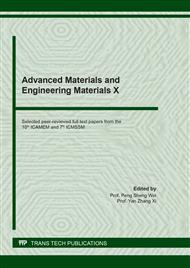[1]
V.H. Dodson, Concrete admixtures, Springer Science & Business Media2013.
Google Scholar
[2]
S.A. Miller, Supplementary cementitious materials to mitigate greenhouse gas emissions from concrete: can there be too much of a good thing?, Journal of Cleaner Production 178 (2018) 587-598.
DOI: 10.1016/j.jclepro.2018.01.008
Google Scholar
[3]
J. Zhang, H. Tan, X. He, W. Yang, X. Deng, Utilization of carbide slag-granulated blast furnace slag system by wet grinding as low carbon cementitious materials, Construction and Building Materials 249 (2020) 118763.
DOI: 10.1016/j.conbuildmat.2020.118763
Google Scholar
[4]
C. Ni, Q. Wu, Z. Yu, X. Shen, Hydration of Portland cement paste mixed with densified silica fume: From the point of view of fineness, Construction and Building Materials 272 (2021) 121906.
DOI: 10.1016/j.conbuildmat.2020.121906
Google Scholar
[5]
M. Morsy, A.M. Rashad, H. Shoukry, M. Mokhtar, S. El-Khodary, Development of lime-pozzolan green binder: The influence of anhydrous gypsum and high ambient temperature curing, Journal of Building Engineering 28 (2020) 101026.
DOI: 10.1016/j.jobe.2019.101026
Google Scholar
[6]
C. Jaturapitakkul, B. Roongreung, Cementing material from calcium carbide residue-rice husk ash, Journal of Materials in Civil Engineering 15(5) (2003) 470-475.
DOI: 10.1061/(asce)0899-1561(2003)15:5(470)
Google Scholar
[7]
S. Liu, D. Wang, J. Guo, L. Zhang, N. Yuan, Pressed recycled fly ash and carbide slag: Hydration of entirely waste-stream building components, Construction and Building Materials 265 (2020) 120282.
DOI: 10.1016/j.conbuildmat.2020.120282
Google Scholar
[8]
N. Makaratat, C. Jaturapitakkul, T. Laosamathikul, Effects of calcium carbide residue–fly ash binder on mechanical properties of concrete, Journal of Materials in Civil Engineering 22(11) (2010) 1164-1170.
DOI: 10.1061/(asce)mt.1943-5533.0000127
Google Scholar
[9]
K. Somna, C. Jaturapitakkul, P. Kajitvichyanukul, Microstructure of calcium carbide residue–ground fly ash paste, Journal of materials in civil Engineering 23(3) (2011) 298-304.
DOI: 10.1061/(asce)mt.1943-5533.0000167
Google Scholar
[10]
ASTM C1240, Standard Specification for Silica Fume Used in Cementitious Mixtures, Annual Book of ASTM Standards, Vol 04.02., (2003).
Google Scholar
[11]
ASTM C150, Standard Specification for Portland Cement, Annual of Book of ASTM Standard, Vol 04.01, (2004).
Google Scholar
[12]
E. Dunstan, How does pozzolanic reaction make concrete green, 2011 World of Coal Ash Conference, May, 2011, pp.9-12.
Google Scholar
[13]
ASTM C109/C109M, Standard Test Method for Compressive Strength of Hydraulic Cement Motars, Annual Book of ASTM Standard, Vol 04.01, (1999).
Google Scholar
[14]
ASTM C305, Mechanical of Hydraulic Cement Pastes and Mortars of Plastic Consistency, Annual Book of ASTM Standard, Vol 04.01, (1999).
Google Scholar
[15]
ASTM C230/C230M, Standard Specification for Flow Table for Use in Tests of Hydraulic Cement, Annual Book of ASTM Standard, Vol 04.01, (2003).
Google Scholar
[16]
ASTM C618, Standard Specification for Coal Fly Ash and Raw or Calcined Natural Pozzolan for Use in Concrete, Annual Book of ASTM Standard, Vol 04.02, (2003).
DOI: 10.1520/c0618-00
Google Scholar
[17]
N.T. Dung, T.-P. Chang, C.-T. Chen, Engineering and sulfate resistance properties of slag-CFBC fly ash paste and mortar, Construction and Building Materials 63 (2014) 40-48.
DOI: 10.1016/j.conbuildmat.2014.04.009
Google Scholar
[18]
H. Taylor, Nanostructure of C- S- H: Current status, Advanced cement based materials 1(1) (1993) 38-46.
Google Scholar


